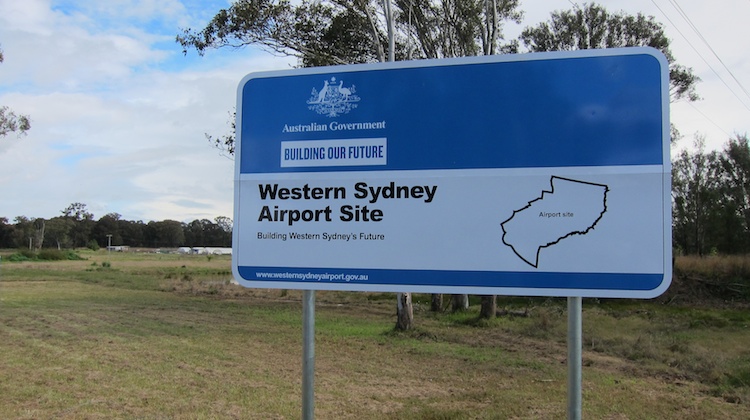
The federal government says it will build and operate the proposed airport at Badgerys Creek after Sydney Airport decided not to take up its right of first refusal to develop the facility.
Sydney Airport said in a statement to the Australian Securities Exchange on Tuesday it had not accepted the Notice of Intention (NOI), or sales contract, to build and operate the proposed Western Sydney Airport (WSA), stating the investment did not meet the company’s investment criteria.
“Sydney Airport’s decision not to accept the WSA NOI on the terms provided is in the best interests of our investors who represent millions of Australians through their superannuation funds,” Sydney Airport chief executive Kerrie Mather said.
“Despite the opportunities that WSA will present, the risks associated with the development and operation of WSA are considerable and endure for many decades without commensurate returns for our investors.”
The decision was not unexpected, given the company had said previously Badgerys Creek would be a challenging investment proposition, given the NOI said Sydney Airport would be responsible for all of the costs of building and operating the airport.
In the NOI, the federal government offered no direct financial support towards building and operating the proposed airport. The cost of construction was estimated to be between $5 billion and $6 billion.
Prime Minister Malcolm Turnbull said Badgerys Creek was a vitally important project for the country.
“The Turnbull Government today confirmed that it will build Western Sydney Airport,” the Prime Minister said in a statement.
“Details of the Turnbull Government’s plan to build Western Sydney Airport will be announced by the Treasurer in the Budget next week.”
“The Government has worked carefully to meet our obligations and we have been planning for either contingency – acceptance or rejection by Sydney Airport Group. We are well positioned to move forward on terms that are consistent with the terms of the Notice of Intention.”
Since the NOI was issued in December 2016, Sydney Airport has sought feedback with the market to determine construction costs of site preparatory works and the aviation infrastructure works, as well as assessed funding options.
The company booked $21 million in expenses, including $16 million in external costs towards the proposed airport, according to its calendar 2016 accounts.
When the Commonwealth sold Sydney Airport in 2002 it included a 30-year first right of refusal to build and operate any airport within 100km of the existing terminals at Mascot.
Minister for Urban Infrastructure Paul Fletcher thanked Sydney Airport for its engagement in the process.
“The consultation meetings with Sydney Airport were conducted in an atmosphere of good faith and I acknowledge their professional and constructive contribution during this process, as well as their strong and positive engagement with western Sydney,” Fletcher said in the Sydney Airport statement.
“I wish the company well in its future endeavours, noting that Sydney Kingsford Smith Airport is Australia’s principal international gateway and plays a vital role in the Australian economy.”
Fletcher has said previously the federal government was ready to build and operate the airport itself or offer the opportunity to private sector companies. Badgerys Creek was expected to be operational by the mid-2020s.
Sydney Airport noted in its statement the right of first refusal allowed the company three months to review the terms on which the government or the private sector would build and run Badgerys Creek.
However, the company said it had been advised by the federal government that the terms would “mirror the NOI received in December 2016, meaning no new option will arise”.
The final Western Sydney Airport Plan shows Stage 1 of the airport would feature a terminal capable of handling up to 10 million domestic and international passengers a year, with a single 3,700m long by 60m wide runway on a 05/23 orientation.
The design of the facility would allow for a second parallel runway and expansion of the terminals to cater for 37 million passengers a year by 2050 and 82 million a year by about 2063.
The terminal design would feature swing gates capable of handling both domestic and international flights, which would increase the efficiency of transfers and increase the use of contact gates equipped with aerobridges.
Meanwhile, jet fuel supply was expected to be delivered by road tanker in a similar way to other airports operating on this scale, such as Canberra and Gold Coast.
And the Airport Plan said flightpaths had not been finalised, noting the draft flightpaths shown in the draft Airport Plan were a “conceptual model for aircraft arrivals”.
The Australian Competition and Consumer Commission (ACCC) said in March an independent or government-owned airport at Badgerys Creek would be a win for airlines and the passengers they carry.
In its annual Airport Monitoring Report for 2015/16, the ACCC said the government’s move to offer no direct financial support towards building and operating the airport was “encouraging”.
“This has raised the possibility of increased competition with Sydney Airport to the long-term benefit of consumers and the economy,” the ACCC report said.
“A second international airport competing with Sydney Airport could yield significant benefits to both consumers and airlines. An independent operator of Western Sydney Airport would have a strong incentive to invest, set competitive prices and offer improved service levels to effectively compete with Sydney Airport.
“On the other hand, a common owner of the two airports would have an incentive to restrict investment and delay the new airport in order to maximise returns from its existing assets.”












